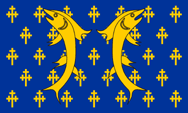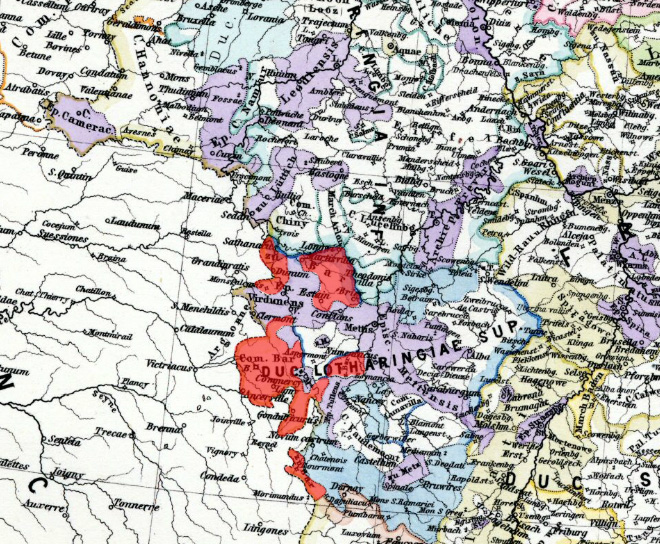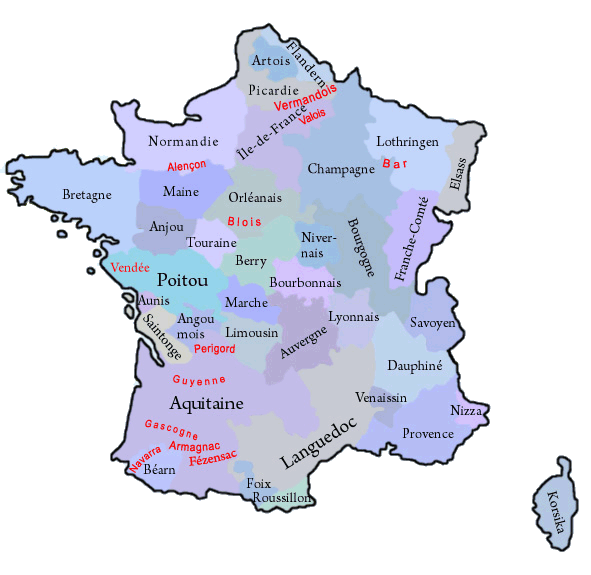mobile View, to the German Version tap the flag


- historical region in France
- former county and duchy
- also called: Barrois
• Flag
• Meaning/Origin of the Flag
• Coat of Arms
• Meaning/Origin of the Coat of Arms
• Map
• Map of the historical Regions in France
• Explanations about the Regions
• History
• Origin of the Country's Name

Flag of Bar (Barrois) – Drapeau de Bar,
Source, by:
Heraldique Europeenne,
heraldry-wiki.com




The flag of Bar is an escutcheon-flag, it shows the image of the coat of arms.
Source:
Volker Preuß


Coat of arms of Bar (Barrois) – Blason de Bar,
Source, by:
Heraldique Europeenne,
heraldry-wiki.com

1040–1419, Scarponnois
Coat of arms of the House of Scarponnois
– Blason de Maison du Scarponnois,
Source, by:
wappenwiki.org

from 1445, Châtenois
Coat of arms of the House of Châtenois
– Blason de Maison du Châtenois,
Source, by:
von Flappiefh, d'après BlackBeast5 (File:COA fr Chatenois Les Forges.svg) [GFDL oder CC BY-SA 3.0], via Wikimedia Commons

The coat of arms of Bar features a blue shield, sprinkled with little golden crosses and topped with two golden barbs. The origin of the arms is not known. But, the coat of arms goes possibly back to the year 1480, when Duke René II. of Lorraine became Duke of Bar, because it can be interpreted as a heraldic combination of the characteristics of the Houses of Scarponnois (from the 11th to the 15th century counts and dukes of Bar), and Châtenois (from 1445 Dukes of bar), after all, the two golden barbs are (House of Scarponnois) combined with a blue background (House of Châtenois).
Source:
Heraldique Europeenne,
Volker Preuß


Source:
Hand-Atlas für die Geschichte des Mittelalters und die neueren Zeit von Spruner and Menke,
modyfied by: Volker Preuß
The map shows – at the and of the 13th century – the south of the Duchy of Lower Lorraine (Ducatus Lotharingiae Inferior) and the Duchy of Upper Lorraine (Ducatus Lotharingiae Superior), and, there within, marked with red, the County of Bar.

The historical, French Regions:

in black: governorate and province in 1776,
in red: former county, province oder governorate
Map: Volker Preuß

The until the French Revolution existing provinces (or governorates) have been historically grown structures, which had their roots oftenly in former fiefdoms of the French crown, historic counties and duchies. They oftenly existed for hundreds of years and had preserved regionality (e.g. cultural particularities and regional languages). On the occasion of the French Revolution such phenomena were of course not desirable, and as part of their bloody and violent egalitarianism any regional references were eliminated. Shortly after the French Revolution the provinces were dissolved and France became divided into many départements, which should have approximately the same size and the same status. The départements were named after rivers or mountains, to use never and in no circumstances the name of an old province. However, there was no success in cutting the connections of the people of France to their respective regions, so that administrative regions were re-created in 1960, to have a better control in regional administrative processes. In this way became départements, which were placed in a historical province, administratively grouped to an oftenly historically named region. The resulted structures coincide only approximately with the boundaries of the old provinces. In the strictly centralist France any regionality is avoided, so that even the official flags of these regions mostly look like flags of companies, unloving, unhistorical, technocratic and modernistic, and these flags should not be a subject of any lexical considerations here. Only in a few of that regions, exist official flags which remember the historical models. But, even the existence of these today's regions is douptful, because in 2014 was passed a territorial reform valid from the year 2016, that reduces the number of the existing regions by merging to nearly the half. However, there exist unofficial flags in nearly all of these regions, which should remember the old provinces and the old heraldry.
Wikipedia Link to the regions of France:
click or tap here
FOTW Link to the regions of France:
click or tap here
Source: Flags of the World,
Wikipedia (D),
Volker Preuß

antiquity/early middle ages · mention of a "Pagus Barensis" (Bargau)
925 · County of Bar (Bar-le-Duc) as part of the German Empire, in the Duchy of Lorraine, as possession of the Bishop of Toul
942 · Frederick, a nobleman from the House of Wiegerich, calls hisself Duke of Lorraine
953 · Lorraine comes to the Archbishop of Cologne, dividing into two duchies, Upper Lorraine (on the lower reaches of the River Moselle) and Lower Lorraine (on the lower reaches of the River Meuse)
955 · Frederick receives the County of Bar, because he exchanged land with the Bishop of Toul, he married in the same year, Beatrix daughter of the Duke of Francia (part of France), what enlarges his estates by the dowry
1040 · Sophia, the heiress of the House of Wiegerich, marries Louis de Mousson from the House of Scarponnois, thus the County of Bar comes to the House of Scarponnois
1302 · Count Henry III. has to acknowledge the suzerainty of France for the areas along the River Meuse (Maas)
1354 · the County of Bar is raised to a duchy
1419 · Louis, Duke of Bar since 1415, cedes the Duchy of Bar to his great-nephew René I. of Anjou (but only the Barrois ducal or non mouvant), René marries Isabella Este, the heiress of the Duke of Lorraine Charles I., the areas along the Meuse River (Barrois royal) shall be recovered by France as a completed fief
1445 · Jolanda, the heiress of Anjou, marries Frederick II. of Vaudémont, emergence of the House of Châtenois
1473 · René II., son of Jolanda and Frederick II., is Duke of Lorraine
1480 · René II. is Duke of Bar (and is concurrently Duke of Lorraine, the two countries are connected from now on)
1552 · King Henry II. of France seizes the Bishoprics of Metz, Toul and Verdun, and occupies the Duchy of Lorraine
1559 · the French withdraw from Lorraine
1618–1648 · Thirty Years' War, King Louis XIII. of France occupies Lorraine in 1632
1659 · Pyrenean Peace, Cardinal Mazarin cedes Lorraine to the German Empire
1670 · King Louis XIV. of France occupies Lorraine
1733 · Polish War of Succession, French troops occupy Lorraine
1738 · Peace of Vienna, Lorraine gets transferred to France, the country retains its seat and vote in the Reichstag and the Kreistag, Duke Franz Stephan receives as compensation the Grand Duchy of Tuscany
1766 · France annexes Lorraine
Source:
Wikipedia (D),
Meyers Konversationslexikon,
Brockhaus Konversationslexikon

The name of the country goes back to the residence of the counts in Bar-le-Duc. But the region must be older, because already in the antiquity or early middle ages is mentioned a "Pagus Barensis" (Bargau).
Source:
Meyers Konversationslexikon,
Volker Preuß


![]()









